Abstract
We reported previously that intraperitoneal administration of a bis(benzyl)polyamine analog, MDL 27,695, suppressed both pentavalent antimony (Sbv)-susceptible and -resistant Leishmania donovani in vivo. The present studies were performed to optimize parasite suppression by parenteral administration and to evaluate the efficacy of oral treatment with MDL 27,695. L. donovani infections in BALB/c mice were suppressed greater than 99% after intraperitoneal dosing for 20 days with a total dose of 150 mg of MDL 27,695 per kg of body weight or 560 mg of Sbv per kg. Suppression was not increased by a total dose of 400 mg of MDL 27,695 per kg given for 20 days. In mice treated for 2, 4, or 7 days with either MDL 27,695 or Sbv (total doses of 60, 120, and 210 mg/kg, respectively), more liver parasites were killed with MDL 27,695 than with Sbv. Assessment of livers posttreatment showed that parasite killing continued for at least 3 days in MDL 27,695-treated mice but not for longer than 1 day in Sbv-treated mice. Intramuscular administration of drugs resulted in 92% parasite suppression by MDL 27,695 (15 mg/kg three times per day for 5 days) and 64% suppression by Sbv (60 mg/kg once per day for 5 days). Dosing of mice by oral gavage with 100 mg of MDL 27,695 per kg twice per day for 14 days resulted in 99.7% parasite suppression, and the 50% effective dose was approximately 11 mg of MDL 27,695 per kg. MDL 27,695 represents an effective new drug potentially useful for oral or parenteral treatment of visceral leishmaniasis.
Full text
PDF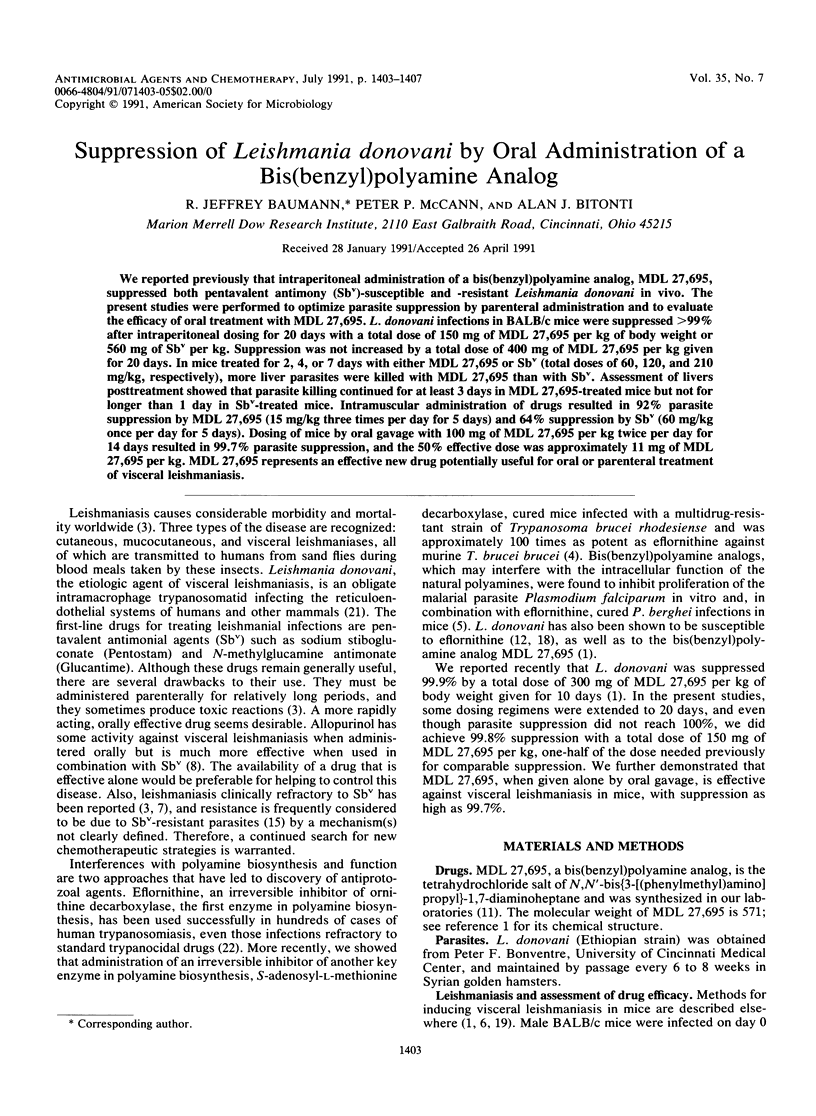
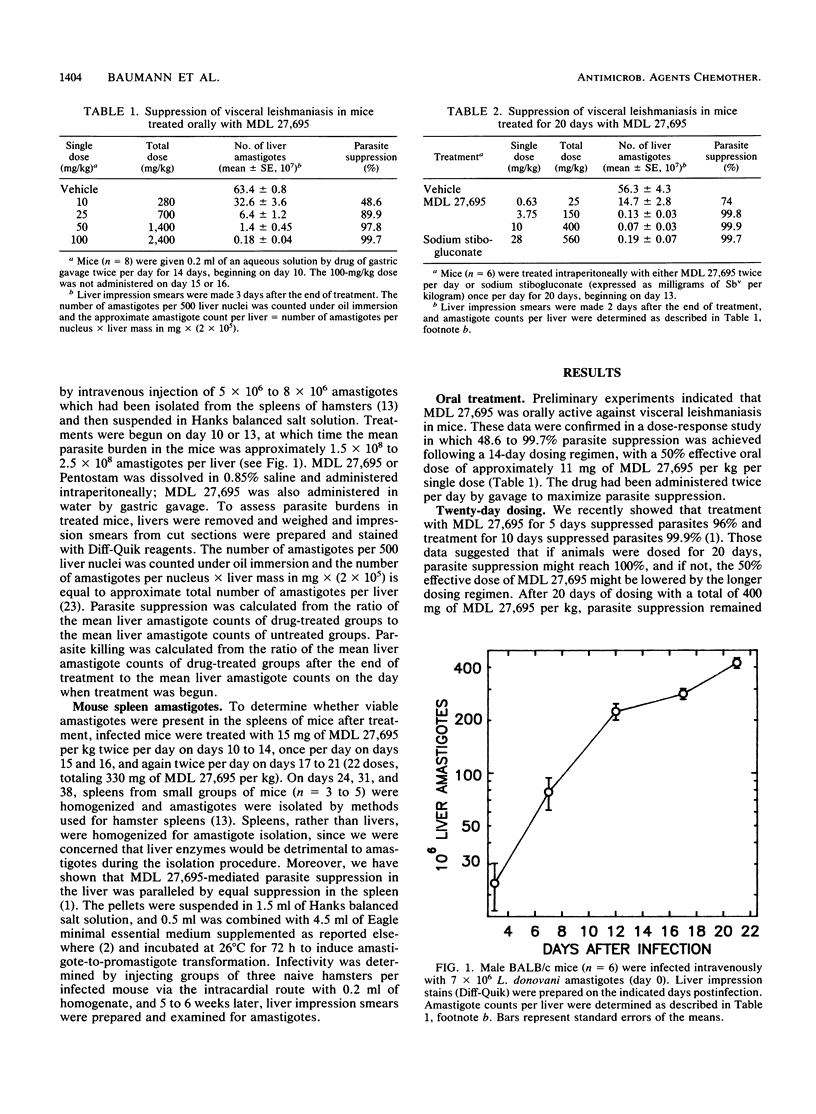
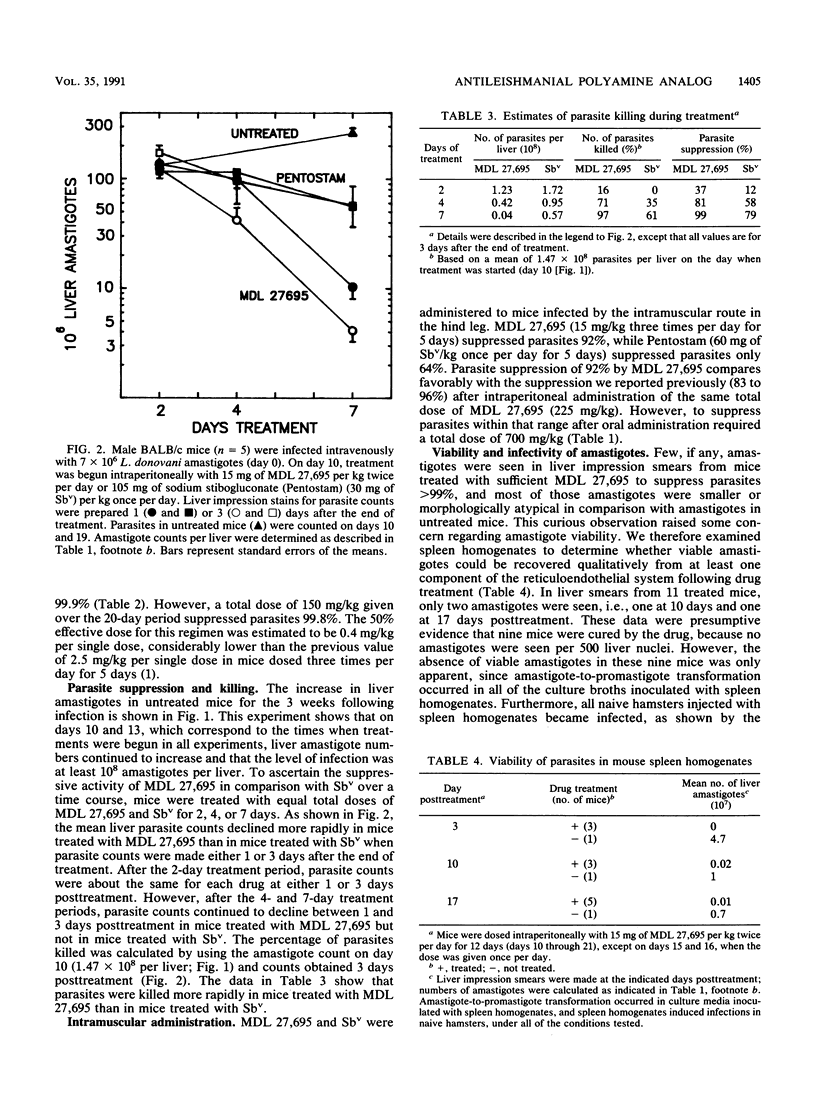
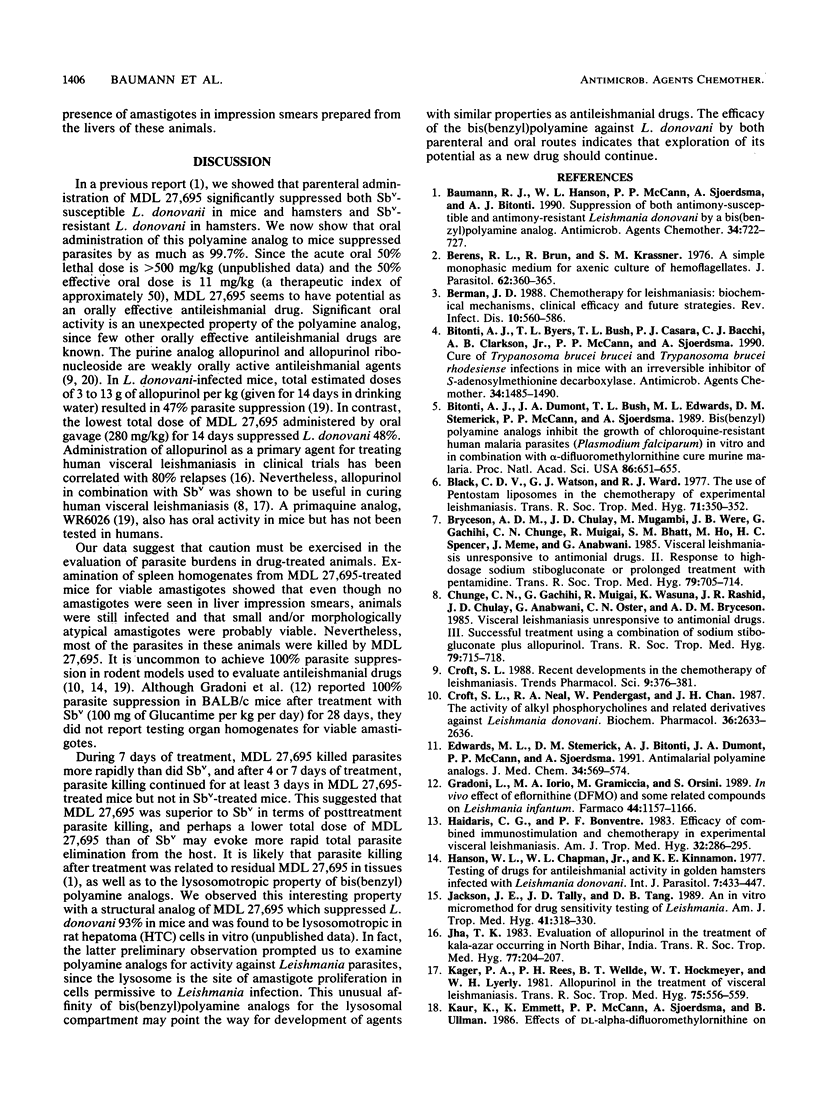
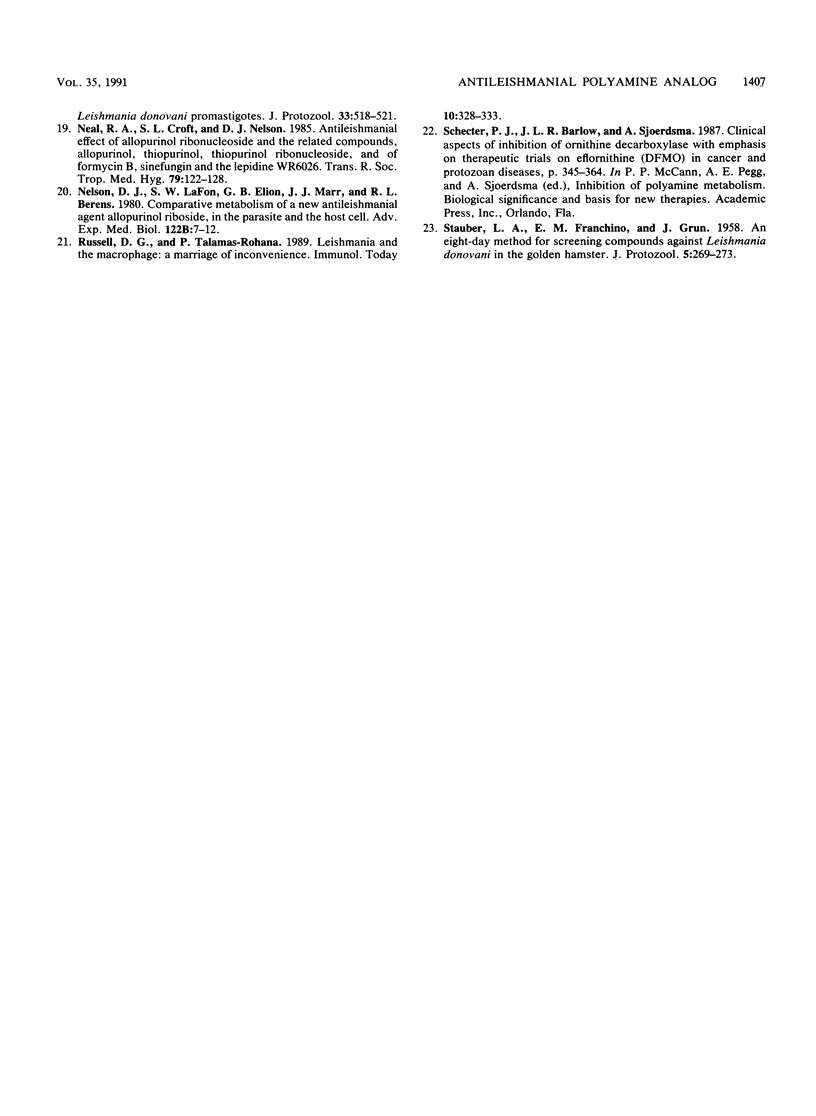
Selected References
These references are in PubMed. This may not be the complete list of references from this article.
- Baumann R. J., Hanson W. L., McCann P. P., Sjoerdsma A., Bitonti A. J. Suppression of both antimony-susceptible and antimony-resistant Leishmania donovani by a bis(benzyl)polyamine analog. Antimicrob Agents Chemother. 1990 May;34(5):722–727. doi: 10.1128/aac.34.5.722. [DOI] [PMC free article] [PubMed] [Google Scholar]
- Berens R. L., Brun R., Krassner S. M. A simple monophasic medium for axenic culture of hemoflagellates. J Parasitol. 1976 Jun;62(3):360–365. [PubMed] [Google Scholar]
- Berman J. D. Chemotherapy for leishmaniasis: biochemical mechanisms, clinical efficacy, and future strategies. Rev Infect Dis. 1988 May-Jun;10(3):560–586. doi: 10.1093/clinids/10.3.560. [DOI] [PubMed] [Google Scholar]
- Bitonti A. J., Byers T. L., Bush T. L., Casara P. J., Bacchi C. J., Clarkson A. B., Jr, McCann P. P., Sjoerdsma A. Cure of Trypanosoma brucei brucei and Trypanosoma brucei rhodesiense infections in mice with an irreversible inhibitor of S-adenosylmethionine decarboxylase. Antimicrob Agents Chemother. 1990 Aug;34(8):1485–1490. doi: 10.1128/aac.34.8.1485. [DOI] [PMC free article] [PubMed] [Google Scholar]
- Bitonti A. J., Dumont J. A., Bush T. L., Edwards M. L., Stemerick D. M., McCann P. P., Sjoerdsma A. Bis(benzyl)polyamine analogs inhibit the growth of chloroquine-resistant human malaria parasites (Plasmodium falciparum) in vitro and in combination with alpha-difluoromethylornithine cure murine malaria. Proc Natl Acad Sci U S A. 1989 Jan;86(2):651–655. doi: 10.1073/pnas.86.2.651. [DOI] [PMC free article] [PubMed] [Google Scholar]
- Bryceson A. D., Chulay J. D., Mugambi M., Were J. B., Gachihi G., Chunge C. N., Muigai R., Bhatt S. M., Ho M., Spencer H. C. Visceral leishmaniasis unresponsive to antimonial drugs. II. Response to high dosage sodium stibogluconate or prolonged treatment with pentamidine. Trans R Soc Trop Med Hyg. 1985;79(5):705–714. doi: 10.1016/0035-9203(85)90199-3. [DOI] [PubMed] [Google Scholar]
- Chunge C. N., Gachihi G., Muigai R., Wasunna K., Rashid J. R., Chulay J. D., Anabwani G., Oster C. N., Bryceson A. D. Visceral leishmaniasis unresponsive to antimonial drugs. III. Successful treatment using a combination of sodium stibogluconate plus allopurinol. Trans R Soc Trop Med Hyg. 1985;79(5):715–718. doi: 10.1016/0035-9203(85)90200-7. [DOI] [PubMed] [Google Scholar]
- Croft S. L., Neal R. A., Pendergast W., Chan J. H. The activity of alkyl phosphorylcholines and related derivatives against Leishmania donovani. Biochem Pharmacol. 1987 Aug 15;36(16):2633–2636. doi: 10.1016/0006-2952(87)90543-0. [DOI] [PubMed] [Google Scholar]
- Croft S. L. Recent developments in the chemotherapy of leishmaniasis. Trends Pharmacol Sci. 1988 Oct;9(10):376–381. doi: 10.1016/0165-6147(88)90258-1. [DOI] [PubMed] [Google Scholar]
- Edwards M. L., Stemerick D. M., Bitonti A. J., Dumont J. A., McCann P. P., Bey P., Sjoerdsma A. Antimalarial polyamine analogues. J Med Chem. 1991 Feb;34(2):569–574. doi: 10.1021/jm00106a015. [DOI] [PubMed] [Google Scholar]
- Gradoni L., Iorio M. A., Gramiccia M., Orsini S. In vivo effect of eflornithine (DFMO) and some related compounds on Leishmania infantum preliminary communication. Farmaco. 1989 Dec;44(12):1157–1166. [PubMed] [Google Scholar]
- Haidaris C. G., Bonventre P. F. Efficacy of combined immunostimulation and chemotherapy in experimental visceral Leishmaniasis. Am J Trop Med Hyg. 1983 Mar;32(2):286–295. doi: 10.4269/ajtmh.1983.32.286. [DOI] [PubMed] [Google Scholar]
- Hanson W. L., Chapman W. L., Jr, Kinnamon K. E. Testing of drugs for antileishmanial activity in golden hamsters infected with Leishmania donovani. Int J Parasitol. 1977 Dec;7(6):443–447. doi: 10.1016/0020-7519(77)90004-2. [DOI] [PubMed] [Google Scholar]
- Jackson J. E., Tally J. D., Tang D. B. An in vitro micromethod for drug sensitivity testing of Leishmania. Am J Trop Med Hyg. 1989 Sep;41(3):318–330. [PubMed] [Google Scholar]
- Jha T. K. Evaluation of allopurinol in the treatment of kala-azar occurring in North Bihar, India. Trans R Soc Trop Med Hyg. 1983;77(2):204–207. doi: 10.1016/0035-9203(83)90071-8. [DOI] [PubMed] [Google Scholar]
- Kager P. A., Rees P. H., Wellde B. T., Hockmeyer W. T., Lyerly W. H. Allopurinol in the treatment of visceral leishmaniasis. Trans R Soc Trop Med Hyg. 1981;75(4):556–559. doi: 10.1016/0035-9203(81)90198-x. [DOI] [PubMed] [Google Scholar]
- Kaur K., Emmett K., McCann P. P., Sjoerdsma A., Ullman B. Effects of DL-alpha-difluoromethylornithine on Leishmania donovani promastigotes. J Protozool. 1986 Nov;33(4):518–521. doi: 10.1111/j.1550-7408.1986.tb05654.x. [DOI] [PubMed] [Google Scholar]
- Neal R. A., Croft S. L., Nelson D. J. Anti-leishmanial effect of allopurinol ribonucleoside and the related compounds, allopurinol, thiopurinol, thiopurinol ribonucleoside, and of formycin B, sinefungin and the lepidine WR6026. Trans R Soc Trop Med Hyg. 1985;79(1):122–128. doi: 10.1016/0035-9203(85)90255-x. [DOI] [PubMed] [Google Scholar]
- Nelson D. J., LaFon S. W., Elion G. B., Marr J. J., Berens R. L. Comparative metabolism of a new antileishmanial agent, allopurinol riboside, in the parasite and the host cell. Adv Exp Med Biol. 1979;122B:7–12. doi: 10.1007/978-1-4684-8559-2_2. [DOI] [PubMed] [Google Scholar]
- Russell D. G., Talamas-Rohana P. Leishmania and the macrophage: a marriage of inconvenience. Immunol Today. 1989 Oct;10(10):328–333. doi: 10.1016/0167-5699(89)90188-6. [DOI] [PubMed] [Google Scholar]


